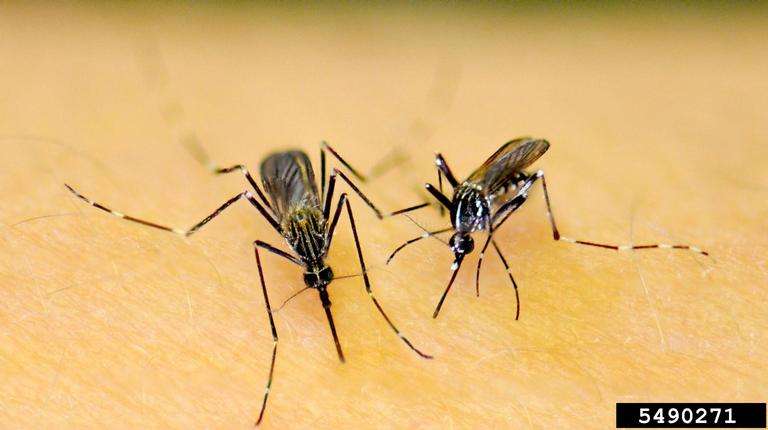Aedes albopictus (left) and Aedes japonicus (right), mosquitoes capable of transmitting the chikungunya virus. Credit: Ary Farajollahi, Bugwood.org
Scientists at a U.S. Army research center have modified an assay that tests whether or not a sample of mosquitoes harbors the virus responsible for the disease known as chikungunya (CHIKV), long a problem in the Old World tropics but recently established in the Americas.
They did not make the assay—a commercial company called VecTOR Test Systems, Inc. did. Instead, the Army researchers tested the test to prove that it works—no small task when dealing with a virus that comes in multiple guises. Their assay is described in an article in the Journal of Medical Entomology.
Health workers now have a quick way to detect the presence of the CHIKV virus within an hour, rather than waiting for results of laboratory tests that take days, or even weeks. It's done with a chemical dipstick, the same kind of simple tool used in a pregnancy test. If the test is positive, measures to control and contain the disease can be mobilized and started immediately, which is important because no vaccine or specific treatment for chikungunya exists.
"Chikungunya" is a term used by people of the Makonde Plateau, between Tanzania and Mozambique, where the disease was discovered in 1952. It means, "that which bends up," referring to the way arthritis caused by the disease crooks posture of the victim's body. Symptoms of chikungunya can be as brutal as its name is to pronounce, although it is seldom fatal. Victims experience fever and pain and swelling of muscles and joints. Headache and rash may occur. The disabling impact can last for months.
To date, tests for CHIKV require expensive equipment in a laboratory setting and technicians who have undergone extensive training. Not so the dipstick test. It can be done on site by a neophyte and, importantly, does not require electricity. The field worker simply has to dip the stick and look for a colored line.
If an outbreak of chikungunya occurs, the test "could enable public health workers to detect CHIKV in infected mosquitoes rapidly without the need for specialized equipment, expertise, or training, making virus surveillance more expedient," according to the authors of the Journal of Medical Entomology article. It would mean the difference between nipping an outbreak in the bud and a major public health crisis.
More information: Journal of Medical Entomology, jme.oxfordjournals.org/lookup/ … i/10.1093/jme/tjv047
Journal information: Journal of Medical Entomology
Provided by Entomological Society of America























